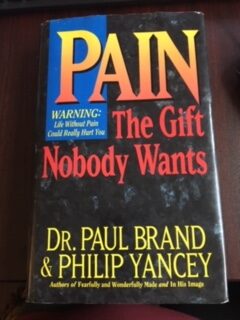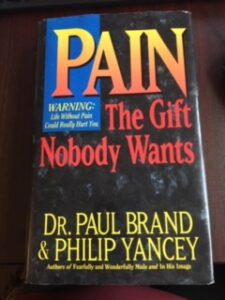This article is a review of the book: Pain, The Gift Nobody Wants, By Dr. Paul Brand and Philip Yancey. The subtitle is: Warning: Life Without Pain Could Really Hurt You. I was given this book by a friend who is a medical professional and who knew how I suffered with chronic pain.
At first I wasn’t motivated to read it. Because yeah, I already knew I didn’t want the “gift” of pain. But I became hooked on the first page as Dr. Brand recounted a story about a four year old girl who couldn’t feel pain.
I admit, I am a sucker for case studies and stories. People fascinate me. I feel we can always learn something from everyone. This book is filled with case studies, based mostly on Dr. Brand’s experiences in his career.
Anyway, as I read, I became familiar with the author and his story. This man dedicated his life to treating patients with leprosy. He came to be recognized as a world renowned hand surgeon. His work to repair hands and feet that had been damaged because of leprosy was groundbreaking.
Certainly, he was someone to be admired. And he had the authority to speak about pain and suffering, so I continued reading the book. I’m glad I did.
Some Facts I Learned
Did you know?
- Leprosy is curable
- It attacks the nerves, thus causing an inability to feel pain
- It is caused by a slow growing bacteria
- You can only catch it by coming in repeated contact with someone who has untreated leprosy
So you can understand the title of the book, because thousands of people with leprosy suffered secondary problems caused by not being able to feel pain. If you want more information on this disease, here is a link to WebMD.
Who Would Read This Book?

Why would you want to read this book? Well, I think it would make you a better person if you did. Why do I think that? Because it is a real life story of a self sacrificing man who gave his life to alleviate the sufferings of others. I believe we are all naturally selfish and self absorbed. This book inspires us to be otherwise.
You should read it because:
- It is inspiring
- It teaches about compassion
- It provides medical and scientific data about a contagious disease that still affects thousands
- It helps you realize you aren’t the only one suffering pain
- It challenges you to be more caring to those who have suffered some sort of deformity
Dr. Brand was a Christian, who truly lived out his faith in serving his fellow man. Who knows what you might learn from this story?
Following are practical lessons I learned that you can use in your life as a sufferer or one who cares for sufferers.
What Makes Things Worse For Pain Sufferers?
Suffering from pain and physical differences is hard enough. Add to that other problems and you magnify the suffering. In chapter 17 of this book, there are some very practical topics that we all need to remember when dealing with pain and suffering. These practices make pain worse. What are they?
- Fear: Fear of a new environment, like a hospital, or of a treatment, rank high on this scale. Fear adds stress to those of us already suffering. If you can provide knowledge and experience in these fearful situations, you are on the road to making the suffering less.
- Anger: Anger at the situation or other circumstances surrounding the pain can interfere with treatment and relief. These feelings must be addressed and overcome for the person to progress toward healing.
- Guilt: Guilt from our past can plague us all. Pain resulting from past experiences may halt the ability of the person to go forward. Some of our cultures look on suffering as punishment from God. We are not in a position to judge that. But the person must be helped to move beyond these feelings. Listening and praying are a good place to start.
- Loneliness: Being cut off from our fellow man can result in more pain. Cultures where the patient is surrounded by family and friends have been shown to hasten healing and health. Conversely, someone left alone to suffer is doubly hurt.
- Helplessness: It appears our western medicine can foster this in patients, making them dependent on doctors and medicine. It has now been scientifically proven that having the sufferer take charge and responsibility for their recovery helps toward pain management and less suffering.
How to Help Someone Who is In Pain
As a chronic pain sufferer, I have become much more aware of fellow pain sufferers. If pain has any place in your life, then I suggest you read this book.
Here’s what I came away with.

Touch
Touch is incredibly powerful to those who suffer. Especially if their appearance isn’t “normal”. They already suffer with pain, and then we ostracize them. Yes, we have to be careful in this day of corona viruses, but when was the last time you put your hand on a shoulder to encourage? Or hugged someone who was sad or down?
Dr. Brand recounts a story where he put his arm around a leprosy patient while presenting his research to a group of doctors in China. He writes, “The doctors around us sucked in their breath sharply. One of them later told me that single act impressed the doctors more than anything else we said or did in China.” (pg 314, Pain, The Gift Nobody Wants)
So as long as you can’t infect someone or they can’t infect you, then touch the pain sufferer. You don’t have any idea how you might lift their spirits.
Focus
I had heard before that occupying your mind can help relieve pain. Dr. Brand explained why. Apparently our brain can only process so much information. So if we are engaged in some other activity or focus, the brain can’t accept the pain signals, and therefore we don’t feel pain.
This is the foundation of the skill of autosuggestion, where some individuals can divert their attention so that they don’t feel pain. Though most of us don’t have the discipline that might take, we can attempt to refocus on other activities to take away pain’s power. In fact, I have an article about this titled Distraction Techniques for Pain. Click on the title to view it.
I have found this to be true in my suffering. Working on my posts and developing my website keeps my mind centered on information, and not on my pain.
AIDS
The author compares the AIDS epidemic to the historical sufferings of those with leprosy. The way our society has treated those suffering this disease has been to ostracize and judge. This is another situation where we need compassion instead of judgment. Especially from those of us who claim to be Christians.
Here’s a short video with the co-author, Philip Yancey talking about the impact Christians have made on the fight against leprosy.
Conclusion
What do you think? Please leave a comment or concern here. I would especially love to hear from you if you have read the book. What did you learn?
It is my hope you have been encouraged and challenged by this article. I hope your day will be made better while you think about this article. Just reading the book will refocus your mind and perhaps relieve your pain for a period of time.
You can purchase a used copy of this book at eBay. Click here. I will receive a small fee for referring you to this link, as I have an affiliate marketing account with them.
And just in case you thought to yourself, I wonder if I could build a website, then go here. The answer is yes! The link will take you to Wealthy Affiliate, the company I am using to build my site. If you want to read a post about what I think of WA, click here.


